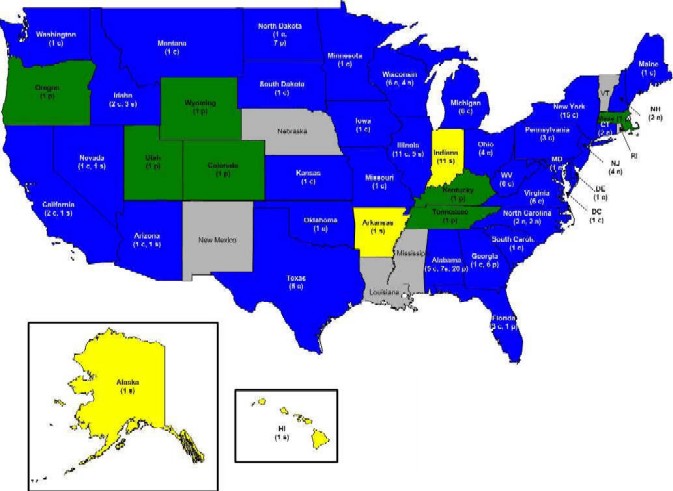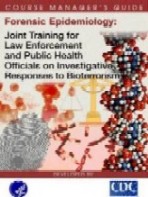|
|
Forensic Epidemiology - Program Details
Selected Outcomes from Forensic Epidemiology
As a result of participating in the Forensic Epidemiology Joint Training
Course, many jurisdictions have taken their training one-step further by
developing after-action reports and legal materials useful to both public health
and law enforcement professionals in their areas. Examples of follow-on
work created as a result of Forensic Epidemiology is detailed in the Final Report
and include among others, the following:
Legal materials from Buncombe County, North Carolina. A collection of
legal materials from Buncombe County, including a Report of the County
Quarantine Task Force, draft quarantine orders, draft isolation orders, a list
of legal authorities and contact persons, and a draft mass quarantine memorandum
of understanding.
- Legal materials from Buncombe County, North Carolina A collection of
legal materials from Buncombe County, including a Report of the County
Quarantine Task Force, draft quarantine orders, draft isolation orders, a list
of legal authorities and contact persons, and a draft mass quarantine memorandum
of understanding.
 (PDF file)
(PDF file)
-
Online Forensic Epidemiology modules available on the
University of North Carolina training website.
- Development of a bioterrorism preparedness field exercise by the U.S.
Attorney's Office for the Eastern District of Pennsylvania and the Federal
Bureau of Investigation field office in Philadelphia
Additionally, the following table displays selected outcomes from
participating states.
| Changes in Policies, Procedures, or Communications |
Follow-on Exercises Initiated by Course Sponsors |
- Updated current statewide paging system
- Created forum promoting communication between forensic and public health
laboratories
- Created a seat on previously "law enforcement only" committees for public
health
- Created a seat on previously "public health only" committees for law
enforcement
- Made $1,500 mini-grants available to each region in Illinois to support course
delivery
- Tested Forensic Epidemiology principles through actual bioterrorism events
(Seattle)
- Dealt with white powder hoaxes in a more efficient manner
- Created Forensic Epidemiology workgroups to discuss HIPAA, evidence
collection, and Emergency Operations
- Developed mock interview script for joint interviews
- Investigated quarantine and isolation policies after a potential outbreak
- Drafted protocols concerning actions during white powder incidents
- Development of a public health laboratory chain of custody form
- Drafted protocols concerning the handling of suspicious packages
- Drafted protocols concerning the assessment of potential bioterrorist events
- Drafted protocols concerning joint inspections
|
- Simulated bioterrorism events
(modified tabletops) including representatives from both law enforcement and
public health
- Bioterrorism preparedness field exercises
- Incident Command System Training Program for Public Health
- Online versions of Forensic Epidemiology course
- Consequent Management exercises
- Advanced Forensic Epidemiology training
- Strategic National Stockpile exercises
|
Training
- A Map of Completed Classes and Future Classes Scheduled (as of 09/2004)
| Scheduled Course: |
|
|
Completed Course: |
|
| Planning Course: |
|
|
Not Scheduled: |
|

-
Training Goal
A primary goal for the training module is to enhance the joint effectiveness
of law enforcement and public health when both disciplines conduct concurrent
investigations in response to a threat or attack involving possible biological
weapons. The module addresses this goal by bringing law enforcement and
public health officials together while working through fact-based case scenarios
involving biological weapons attacks or threats. The CDC's goal was to
have 2/3 of the states (34 states) trained in Forensic Epidemiology by September
30, 2004. In fact, 42 states and territories had completed the training by
September 30, 2004. The total is projected to reach 44 by the end of October
2004.
-
Training Strategies
The module's centerpiece is a set of three fact-based case scenarios worked
through by small groups; the small groups, which include equal numbers of law
enforcement and public health officials, address key objectives by reviewing
sets of facts, then answering questions matched to the objectives. The
objectives span a spectrum of issues, including, for example: conducting
epidemiological investigations and public health responses in the setting of a
crime scene; meshing criminal investigative procedures with epidemiological,
laboratory, and other scientific procedures in such settings; and joint law
enforcement and public health operations and communications. In addition
to improving understanding of relevant laws, approaches, and procedures, the
module's delivery is designed to increase participants' familiarity with their
law enforcement and public health counterparts in their home jurisdictions.
The module also employs a "train-the-trainers" strategy to emphasize peer
teaching and to create a force-multiplier capacity for sustainable, additional
training within a state or other jurisdictional level.
Course Manager's Guide
The Course Manager's Guide is a self-contained instructional package that can
be used as an instructional template in any jurisdiction in the United States.
The guide's focus is to summarize and simplify the 10 important items that must
be done to implement the Forensic Epidemiology course.

|
- Establish a local planning committee
- Select course design
- Select a facility
- Choose participants
- Select presenters
- Elect facilitators from the participants
- Assemble binders
- Conduct facilitator training
- Determine breakout groups
- Conduct training
|
The guide provides detailed information on planning, course design, and
logistics, and includes template presentations, case studies, and supplemental
reference material.
The guide, currently packaged as a CD, is available free of charge from the
CDC. To obtain a copy of the CD, please contact Andrea Hines at 404-639-4693
or anh1@cdc.gov.
The Course Manager's Guide is updated when changes are needed. Currently,
version 1.3 of the Course Manager's Guide is available. A list of modifications
can be downloaded using the link below.
 Course Manager's Guide
Course Manager's Guide
Modification
 (PDF file)
(PDF file)
How to Fund the Course
-
CDC Grant: The CDC has provided $5,000 to each state health department's bioterrorism grant
by way of the cooperative agreements. This supplement was added in September
2003. The award number is U90/CCU116972-04. To download a copy of
the one-page information sheet on the grant,
please click here.
 (PDF file)
(PDF file)
-
Other sources: There are other funding
mechanisms available to help pay for the Forensic Epidemiology Training. These
include:
- U.S. Attorney's Offices - LECC and ATTF funds
- State bioterrorism grants (focus area G)
- FBI - WMD funds
- Regional task force funds
- State law enforcement division funds
- Schools of Public Health
- Local health offices
- Health Resources Services Administration (HRSA)
- DOJ Office of Domestic Preparedness
- Center for Bioterrorism Education
- Centers for Public Health Preparedness
housed at schools of public health
- State crime commission
- State/county grants
- FEMA
- Military base facilities
Additional Resources
- Useful Resources
A list of useful resources that can be found online is included in this
guide. This list includes planning guidances, reports, and decision trees that
can be useful when discussing bioterrorism preparedness.
The general link for all of the Improved Military Response Program Products
is: http://www.ecbc.army.mil/hld/mirp.htm
Biological Weapons Improved Response Program (BW IRP)
Updated BW Response Decision Tree and BW Response Template, May 2001
ECBC_bwirp_updated_decision_tree_rep.pdf
Community Outreach / Mass Prophylaxis Pamphlet: A Mass Casualty Care
Strategy for Biological Terrorism Incidents (June 2002)
ECBC_comp_mass_casualty_care.pdf
Executive Summary of Biological Warfare Improved Response Program U.S.
Department of Agriculture and Department of Defense (USDA/DoD) Workshop (August
1999)
ECBC_bwirp_usda_dod_ws_exec_sum.pdf
Interim Planning Guide: Improving Local and State Agency Response to
Terrorist Incidents Involving Biological Weapons - Interim Planning Guide
(September 2000)
SBCCOM-ImprovingResponse.pdf
NPDO/DoD Criminal and Epidemiological Investigation Report (January 2000)
ECBC_bwirp_npdo_dod_ceir.pdf
Biological Weapons Improved Response Program (BW IRP) Response Decision
Tree Workshop
ECBC_bwirp_decision_tree_report.pdf
- Criminal and Epidemiologic Investigation Handbook
The FBI Criminal and Epidemiological Investigation Handbook is extremely
useful when discussing bioterrorism preparedness. It provides background on
public health, law enforcement, and joint operations. To download a copy of the
Handbook, please click here
 (PDF file)
(PDF file)
- Resources for Public Health Legal Response
Selected legal resources for public health lawyers on response and
preparedness for public health problems are available on the CDC's Public Health
Law Program website. Please click here to access this information.
- CDC's Emergency Preparedness and Response Website
This website includes emergency preparedness and response information for
professionals and the public. Please click here to access the information.
Frequently Asked Questions
- What is the typical course agenda?
For a copy of agenda click here.
 (Word file)
(Word file)
- Are there ways of modifying this course to reflect my jurisdiction's needs?
Yes, there are ways of modifying the course to fit your jurisdiction's needs.
- Is the course being updated?
The Course Manager's Guide is updated when changes are
needed. Currently, version 2.0 of the Course Manager's Guide is available.
A list of modifications can be downloaded using the link below.
Modification
 (PDF file)
(PDF file)
|
